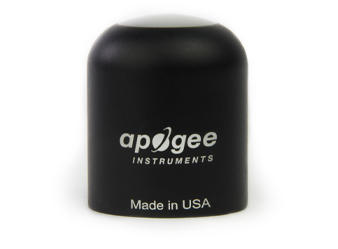Underwater PAR Measurements
This phenomenon is called the immersion effect and happens because the refractive index of water (1.33) is greater than air (1.00). The higher refractive index of water causes more light to be backscattered (or reflected) out of the sensor in water than in air (Smith, 1969; Tyler and Smith, 1970). As more light is reflected, less light is transmitted through the diffuser to the detector, which causes the sensor to read low. When this effect is not corrected for, underwater measurements are only relative, which makes it difficult to compare light in different environments.
The Apogee Full-Spectrum Quantum Sensor (model SQ-500) is more spectrally accurate than the Original X Quantum Sensor (model SQ-100X), but the unique optics (mainly the shape) cause the immersion effect to be larger for the new sensor. Underwater PAR measurements collected using a full-spectrum sensor can be corrected by multiplying by 1.25; measurements collected using an original X Apogee sensor should be multiplied by 1.15*.
*The MQ-210X and MQ-510 Underwater Quantum Meters already apply the immersion effect correction factor to the meter readings through the meter firmware. Additionally, the SQ-420X and SQ-520 have an "Immersion Setting" that applies the immersion effect correction factor to the sensor readings through the ApogeeConnect Software. These sensors do not need post-measurement corrections applied to their measurements.
In 2021, Apogee also found the immersion correction factors for the Apogee PAR-FAR sensor (model S2-141), Red - Far-red sensor (model S2-131), Extended Range PFD and the Quantum Light Pollution sensors (models SQ-620 and SQ-640), and our UV-A sensor (model SU-200).
For details on how these multipliers were determined, read the white paper on Apogee's Immersion Effect Correction Factors for Quantum Sensors
Immersion Effect Correction Factors
Full-Spectrum Quantum Sensor

1.25 (or 1.32 for older analog sensors, please check product manuals)
Original X Quantum Sensor

1.15 (or 1.08, please check product manuals)
ePAR Sensor

1.25
PAR-FAR Sensor

1.25
Articles Featuring Apogee's Underwater Quantum Meters
